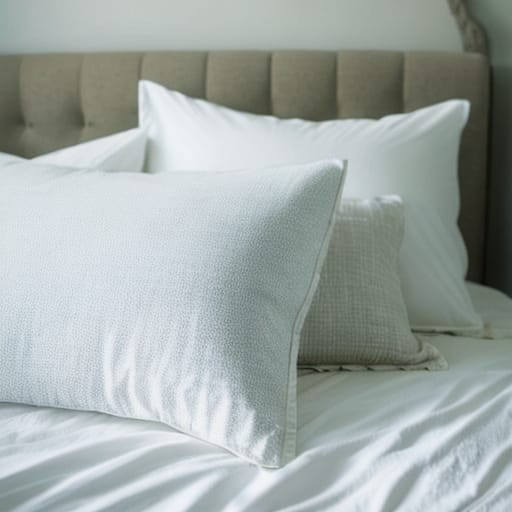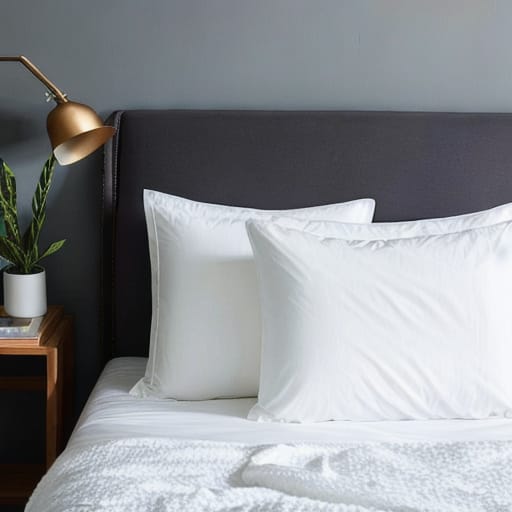When it comes to bedding essentials for a warm, comforting sleep, few compare to a down duvet. Often confused with down comforters, down duvets are filled with feather and down-insulating materials and covered by a soft, breathable shell. They can provide just the right level of light, and airy warmth without becoming overly hot.
But with so many options on the market, how do you determine which down duvet is the best choice for your bedroom? This beginner’s guide will teach you everything you need to know, from fill power ratings to shell materials. Read on to learn insider tips for selecting a high-quality down duvet that suits your sleep needs and budget.
What is a Down Duvet?
A down duvet is a type of quilt or comforter filled with natural down sourced from duck or geese. Down refers to the layer of delicate, fluffy feathers closest to a bird’s skin that helps insulate them from weather.
On their own, down feathers don’t have much structure. So they need to be combined with more resilient feathers and stitched into fabric casings to create a duvet or pillow. The result is an incredibly soft, cushy insert that traps body heat without weighing you down.
Benefits of Down Duvets
Down duvets offer exceptional comfort and craftsmanship. Here’s why you might consider one for your bed:
- Lightweight warmth – Down is highly efficient at providing insulation and trapping ambient heat from your body. An 850-fill power-down duvet can keep you cozy minus the weight.
- Breathability – Air can circulate between plush-down feathers so heat dissipates rather than accumulating. This prevents sweatiness.
- Fluffiness – Premium Down offers hotel-style luxury that envelops your body gently while you sleep.
- Durability – With proper care, high fill power down maintains loft and performance for over 10 years.
Down vs Down Alternative Duvets
Not all duvets contain true goose or duck down. Many affordable options use down alternative fill made from polyester instead.
The main distinction is cost. Real down is still considered the gold standard but comes with a higher price tag based on rarity and labor-intensive production. Meanwhile, down alternatives replicate properties of natural down at a fraction of the price point.
Below is a comparison chart summarizing the key differences:
| Property | Goose Down | Duck Down | Down Alternative |
|---|---|---|---|
| Cost | Highest | Middle | Lowest |
| Durability | 10+ Years | 7-10 Years | 2-5 Years |
| Allergen-Free | No | No | Yes |
| Warmth | Excellent | Very Good | Good |
| Fluffiness | Maximum | Good | Average |
While alternative duvets can save money upfront, they tend to degrade faster so require replacing sooner. Choosing between real and synthetic down depends on your budget and desired longevity.

How to Choose a Down Duvet
Purchasing a down duvet involves evaluating several components that affect overall quality and performance. Keep these factors in mind while comparing options:
Fill Power
The fill power of down refers to the fluffiness and insulation. It measures the space one ounce of down fills in cubic inches when fully lofted and ranges from 400 to 900. Higher numbers indicate better cloud-like density and greater warmth efficiency.
- 850+ fill power – Maximum loft and lightweight insulation
- 600-800 fill power – Ideal for year-round use
- Under 500 fill power – More affordability but less warmth
Select fill power based on your climate conditions and sensitivity to hot or cold sleeping environments. High fill down works well for cold weather or air-conditioned bedrooms while low fills suit warmer beds.
Shell Fabric
Down fill is contained within an outer shell fabric, usually made of cotton, polyester, or poly-cotton blends. Shell materials should have tight weave construction to prevent feathers from poking through.
- Cotton shells feel ultra-soft and breathable against the skin but wrinkle easily.
- Polyester microfiber resists shrinking and is moisture-wicking but can sleep hot.
- Poly-cotton blends balance durability, ventilation, and easy care.
Consider shell fabric permeability and whether you tend to sleep hot or cold. Test out different materials to determine what feels best for nighttime comfort.
Stitching Method
Look inside a down duvet and you’ll notice segmentation or boxes that prevent filling from shifting. These compartments are made using either sewn-through or baffle box construction.
- Sewn-through duvets have simple vertical and horizontal seams that outline small boxes. They’re less expensive to produce but down can shift to the sides overtime.
- Baffle box duvets contain larger boxes made of fabric walls that allow down to fully expand in 3 dimensions. This maintains maximum thickness and insulation.
Baffle box stitching leads to extra long-lasting performance. So it’s worth investing in despite moderately higher prices.
Best Down Duvets 2023
Based on extensive research and down duvet reviews, these are the top-rated goose and duck down-filled duvets across price ranges:
| Best Overall | Best Luxury | Best Budget | Best Alternative |
|---|---|---|---|
| Parachute Home Down Duvet | Snowe Down Duvet | Buffy Cloud Down Duvet | Utopia Bedding Down Alternative Duvet |
| $349-$419 | $248-$358 | $251-$281 | $33.99-$279.99 |
| ⭐⭐⭐⭐⭐ | ⭐⭐⭐⭐⭐ | ⭐⭐⭐⭐ | ⭐⭐⭐⭐ |
| 100% ethically-sourced white goose down | 600 to 800 fill power | Duck down + feathers | Polyester microfiber fill |
| Available in 3 warmth ratings | Breathable, luxury cotton shell | Available in 3 sizes | Hypoallergenic |
| Lifetime warranty | Lightweight warmth | Recycled fabrics | Lowest price |
Parachute – This premium Canadian white goose down duvet earns top marks for unbeatable quality and construction. The baffle box design showcases 750 to 900 fill power down secured in a soft, 400 thread count sateen cotton shell. It’s certified by the Responsible Down Standard (RDS) for ethical production.
Snowe – For a more affordable luxury goose-down with impressive loft, Snowe is a standout. A breathable 400 thread count cotton shell encloses rich 550 to 750 fill power down neatly segmented into baffle boxes. The AEOS eucalyptus fiber fill offers a lavender-scented, hypoallergenic alternative.
Buffy – This newer brand focuses on sustainability using BCI-certified cotton and recycled materials at affordable prices. The cloud-down duvet contains a mix of 75% duck down and 25% small duck feathers. The shell fabric is made from recycled PET bottles.
Utopia Bedding – If seeking a budget-friendly down alternative, customers rave about Utopia’s box-stitched microfiber duvet. It mimics the qualities of real goose down minus animal products. Siliconized fiberfill avoids clumping. Sizes come in twin up to the king.

Down Duvet Care Tips
Caring properly for a down duvet will help it maintain insulation, loft, and durability over regular machine wash cycles. Here are handy care instructions:
- Check manufacturer guidelines before washing
- Use a large capacity washer on the gentle cycle
- Add a couple of clean tennis balls to the drum to fluff during cleaning
- Use mild soap without dyes or fabric softener
- Dry thoroughly on low heat, re-fluffing every 20 minutes
- Store covered in breathable cotton when not in use
- Air out the down regularly to maximize loft
With the right certified humane down fill, baffle box construction, breathable shell fabric and regular cleaning, a quality down duvet can promote restful sleep for over a decade. Do your research to find the perfect match for your bedroom. The investment in a winter-worthy bed topper than envelops you in gentle warmth is well worth it.
Frequently Asked Questions
What’s the difference between a duvet and comforter?
A duvet refers specifically to the removable insulating insert filled with down, feathers or alternative materials. A comforter is generally used to describe the entire composite piece including the duvet insert along with the protective duvet cover. The terms are sometimes used interchangeably.
Should I get a goose down or duck down duvet?
Goose down is considered superior for providing lightweight warmth and maximum fluffiness. However, duck down offers comparable good performance for a lower price point. Ultimately it depends on your budget and desired balance of qualities.
How do I choose the right tog rating?
Tog ratings measure the warmth provided by a duvet insert. Choose higher tog rated duvets around 13.5 or more for cold winter weather and lower ratings around 3-7 for warmer climates or seasons.
What thread count is best for a down duvet?
Higher cotton thread counts around 400-500 offer the greatest softness and breathability against skin. However, too high over 600 can compromise air permeability. Moderate thread counts balance comfort with ventilation to prevent moisture buildup.
Should I get alternative down or real down?
True goose or duck down still surpasses synthetic alternatives for durability, lasting over a decade with proper care. However alternative down costs a fraction at usually under $100. So choose based on your budget and preference for natural or manmade fill.








